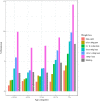Epidemiology of type 2 diabetes remission in Scotland in 2019: A cross-sectional population-based study
- PMID: 34727107
- PMCID: PMC8562803
- DOI: 10.1371/journal.pmed.1003828
Epidemiology of type 2 diabetes remission in Scotland in 2019: A cross-sectional population-based study
Abstract
Background: Clinical pathways are changing to incorporate support and appropriate follow-up for people to achieve remission of type 2 diabetes, but there is limited understanding of the prevalence of remission in current practice or patient characteristics associated with remission.
Methods and findings: We carried out a cross-sectional study estimating the prevalence of remission of type 2 diabetes in all adults in Scotland aged ≥30 years diagnosed with type 2 diabetes and alive on December 31, 2019. Remission of type 2 diabetes was assessed between January 1, 2019 and December 31, 2019. We defined remission as all HbA1c values <48 mmol/mol in the absence of glucose-lowering therapy (GLT) for a continuous duration of ≥365 days before the date of the last recorded HbA1c in 2019. Multivariable logistic regression in complete and multiply imputed datasets was used to examine characteristics associated with remission. Our cohort consisted of 162,316 individuals, all of whom had at least 1 HbA1c ≥48 mmol/mol (6.5%) at or after diagnosis of diabetes and at least 1 HbA1c recorded in 2019 (78.5% of the eligible population). Over half (56%) of our cohort was aged 65 years or over in 2019, and 64% had had type 2 diabetes for at least 6 years. Our cohort was predominantly of white ethnicity (74%), and ethnicity data were missing for 19% of the cohort. Median body mass index (BMI) at diagnosis was 32.3 kg/m2. A total of 7,710 people (4.8% [95% confidence interval [CI] 4.7 to 4.9]) were in remission of type 2 diabetes. Factors associated with remission were older age (odds ratio [OR] 1.48 [95% CI 1.34 to 1.62] P < 0.001) for people aged ≥75 years compared to 45 to 54 year group), HbA1c <48 mmol/mol at diagnosis (OR 1.31 [95% CI 1.24 to 1.39] P < 0.001) compared to 48 to 52 mmol/mol), no previous history of GLT (OR 14.6 [95% CI 13.7 to 15.5] P < 0.001), weight loss from diagnosis to 2019 (OR 4.45 [95% CI 3.89 to 5.10] P < 0.001) for ≥15 kg of weight loss compared to 0 to 4.9 kg weight gain), and previous bariatric surgery (OR 11.9 [95% CI 9.41 to 15.1] P < 0.001). Limitations of the study include the use of a limited subset of possible definitions of remission of type 2 diabetes, missing data, and inability to identify self-funded bariatric surgery.
Conclusions: In this study, we found that 4.8% of people with type 2 diabetes who had at least 1 HbA1c ≥48 mmol/mol (6.5%) after diagnosis of diabetes and had at least 1 HbA1c recorded in 2019 had evidence of type 2 diabetes remission. Guidelines are required for management and follow-up of this group and may differ depending on whether weight loss and remission of diabetes were intentional or unintentional. Our findings can be used to evaluate the impact of future initiatives on the prevalence of type 2 diabetes remission.
Conflict of interest statement
I have read the journal’s policy and the authors of this manuscript have the following competing interests: BK is national lead for diabetes and chair of the Scottish Diabetes Group which sits directly within the Clinical Priorities team at Scottish Government, member of the Type 2 Diabetes Prevention Oversight group which is a Scottish Government related group, speciality adviser to Chief Medical Officer for diabetes and endocrine. RL has served on advisory boards with Novo Nordisk, Lily and Servier only NS has consulted for Amgen, AstraZeneca, Boehringer Ingelheim, Eli Lilly, Merck Sharp & Dohme, Novartis, Novo Nordisk, Pfizer, and Sanofi, and received grant support from Boehringer Ingelheim, Novartis and Roche, outside the submitted work.
Figures




References
-
- International Diabetes Federation. IDF Diabetes Atlas 2019 [24.08.2020]. 9th. Available from: https://www.diabetesatlas.org/upload/resources/material/20200302_133351_....
-
- Nagi D, Hambling C, Taylor R. Remission of type 2 diabetes: a position statement from the Association of British Clinical Diabetologists (ABCD) and the Primary Care Diabetes Society (PCDS). Brit J Diab. 2019;19(1):73–6. doi: 10.15277/bjd.2019.221 - DOI
-
- International Diabetes Federation. Recommendations for Managing Type 2 Diabetes in Primary Care 2017 [26.08.2020]. Available from: www.idf.org/managing-type2-diabetes.
Publication types
MeSH terms
Substances
Grants and funding
LinkOut - more resources
Full Text Sources
Medical

